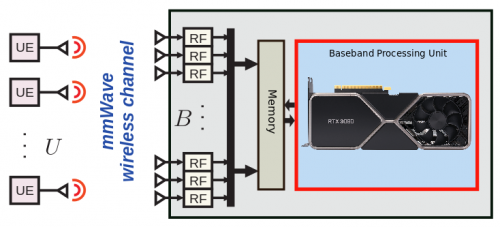Difference between revisions of "Beamspace processing for 5G mmWave massive MIMO on GPU"
From iis-projects
| Line 50: | Line 50: | ||
==Links== | ==Links== | ||
| − | [[Category:Completed ]] | + | [[Category:Completed]] |
| + | [[Category:IIP_PIM]] | ||
[[Category:IIP]] | [[Category:IIP]] | ||
| − | [[Category: | + | [[Category:2021]] |
[[#top|↑ top]] | [[#top|↑ top]] | ||
Revision as of 00:16, 11 January 2022
Contents
Short Description
Millimeter-wave (mmWave) communication is a key technology component of 5G and beyond 5G (B5G) as it offers a significant increase in data-rates due to the availability of large unused frequency bands. However, wave propagation at such high frequencies suffers from strong attenuation. The main solution to combat the high attenuation is beamforming using large antenna arrays, an emerging technique known as massive multiple-input multiple-output (MIMO). However, realization of mmWave massive MIMO faces practical challenges due to the (i) high baseband sampling rates required to support large bandwidths, resulting in excessive throughput requirements, and (ii) large number of antennas required for massive MIMO, which increases the dimension of the data to be processed. Beamspace processing is an emerging paradigm to mitigate these implementation challenges by leveraging the inherent sparsity of mmWave channels in the angular domain. This approach exploits channel sparsity during baseband processing, which results in reduced complexity compared to conventional antenna-domain processing.
Graphics processing units (GPUs) are computing devices optimized for massively-parallel matrix-vector operations. Many of the critical wireless baseband processing tasks heavily rely on such operations and have the potential to be parallelized. With the ongoing standardization of 5G, many new algorithms are being investigated, which sparks the interest in highly programmable computing platforms for baseband processing. Additionally, there is growing interest from GPU vendors to invest in the wireless communication industry. Hence, it is the perfect time to prototype new algorithms designed for 5G and B5G on GPUs, including beamspace processing algorithms that have been developed very recently [1,2].
In this project, the students will implement the core algorithms of a mmWave massive MIMO receiver chain on a GPU, including fast Fourier transform (FFT) and beamspace channel estimation and data detection algorithms, such as BEACHES, COMP, and EOMP [1], [3]. The goals are to (i) identify the key processing bottlenecks and (ii) assess the efficacy of GPUs for 5G and B5G baseband processing. If time permits, the students can explore and design new channel estimation and data detection algorithms that better exploit beamspace sparsity and further reduce the complexity when implemented on GPUs.
[1] S. H. Mirfarshbafan and C. Studer, “Sparse beamspace equalization for massive MU-MIMO mmWave systems,” in Proc. IEEE Int. Conf. Acoust., Speech, Signal Process. (ICASSP), May 2020, pp. 1773–1777.
[2] M. Mahdavi, O. Edfors, V. Öwall, and L. Liu, “Angular-domain massive MIMO detection: Algorithm, implementation, and design tradeoffs,” IEEE Trans. Circuits Syst. I, vol. 67, no. 6, pp. 1948–1961, Jan. 2020.
[3] S. H. Mirfarshbafan, A. Gallyas-Sanhueza, R. Ghods, and C. Studer, “Beamspace channel estimation for massive MIMO mmWave systems: Algorithm and VLSI design,” IEEE Trans. Circuits Syst. I, pp. 1–14, Sep. 2020
Status: Completed
- Student: Caroline Dick
- Date: Spring Semester 2021 (bsc21f5)
- Supervision: Seyed Hadi Mirfarshbafan
Prerequisites
- C/C++ programming
- Familiarity with CUDA programming (optional)
- Familiarity with communications systems and algorithms (optional)
Character
- 80% GPU implementation
- 20% algorithm design
Professor
